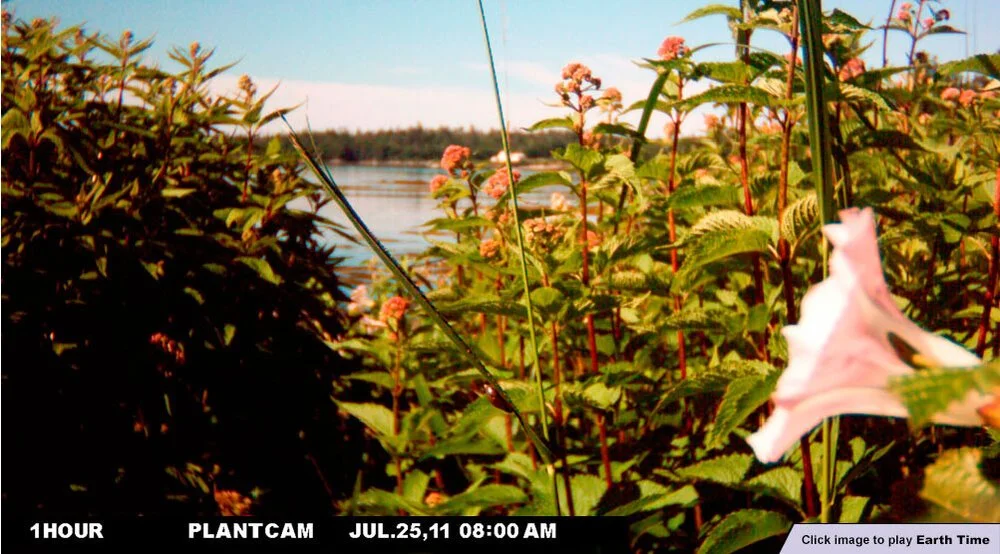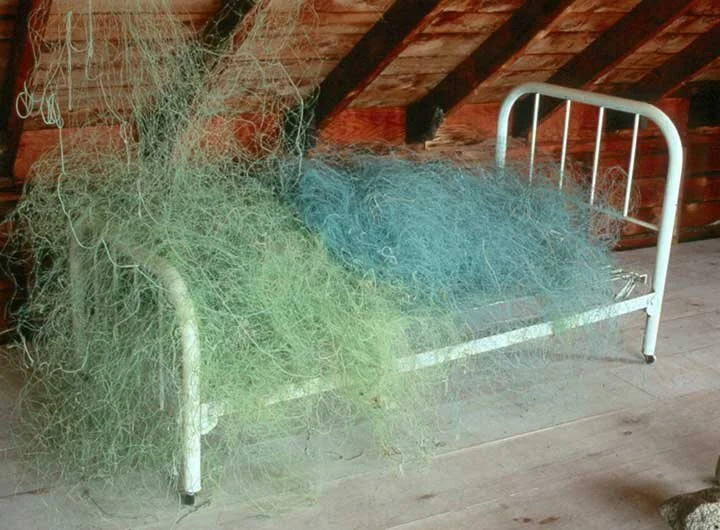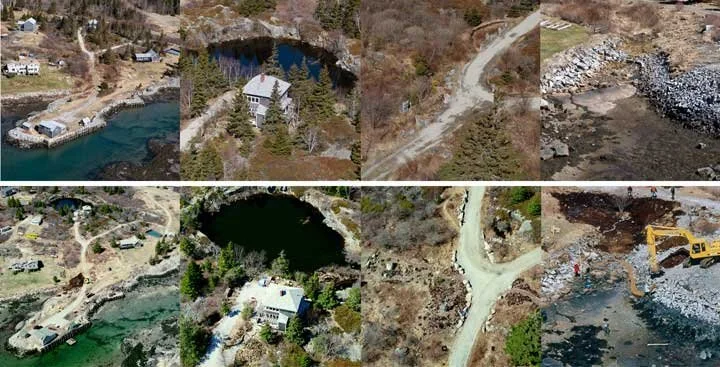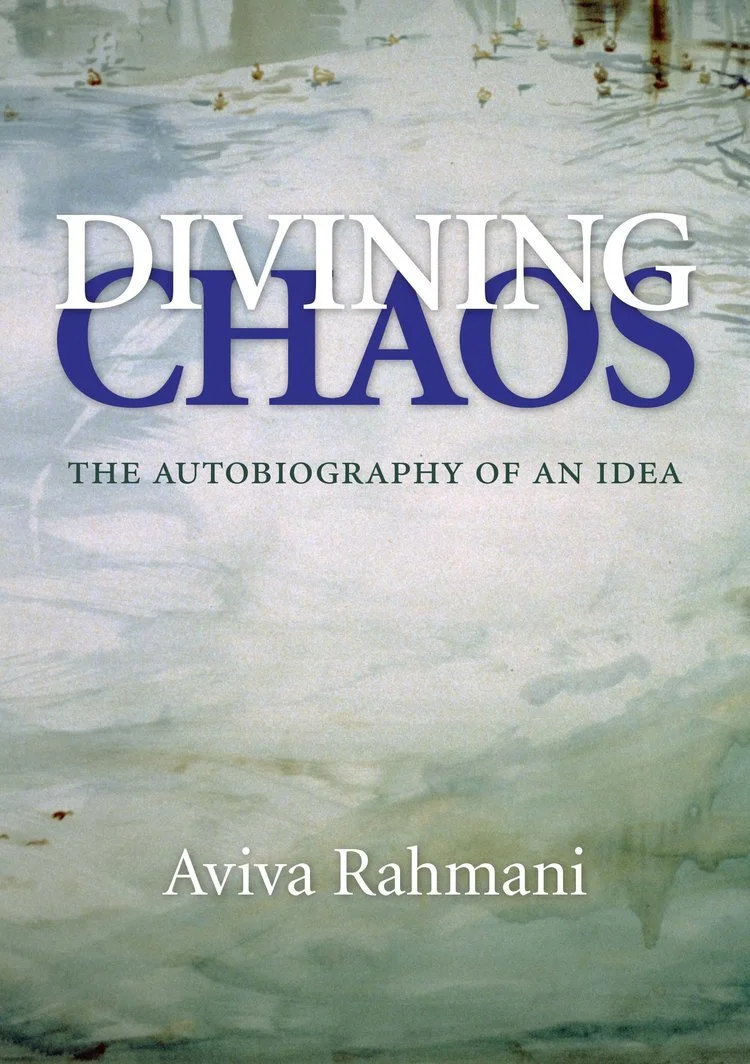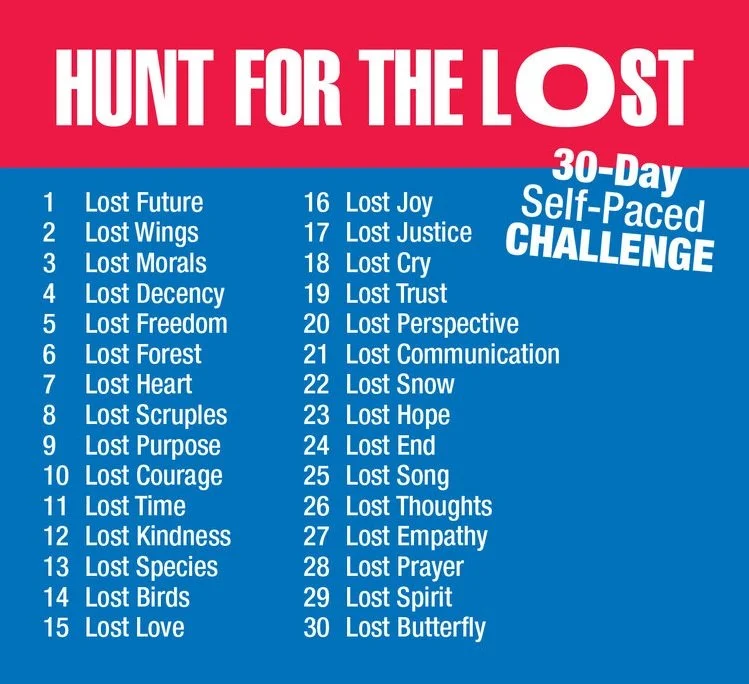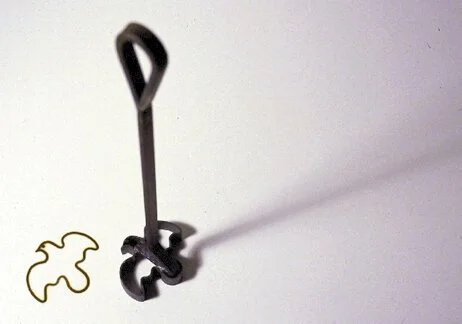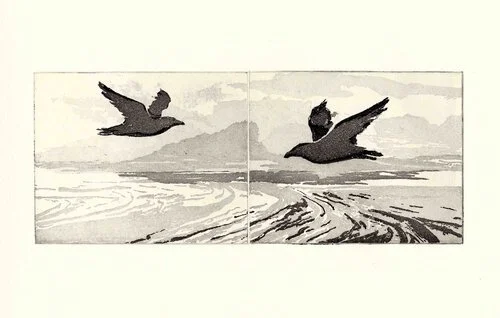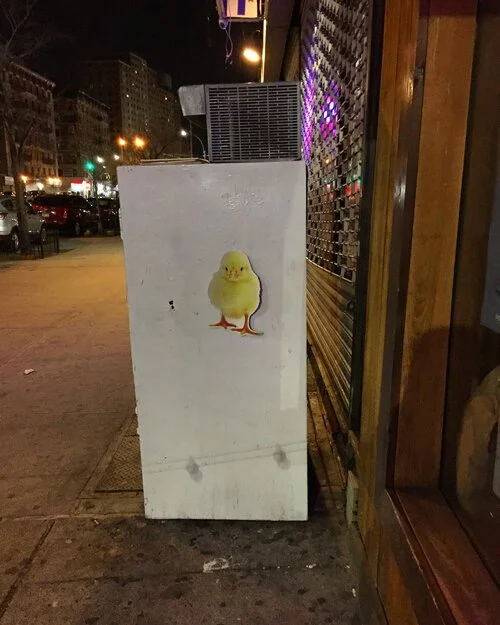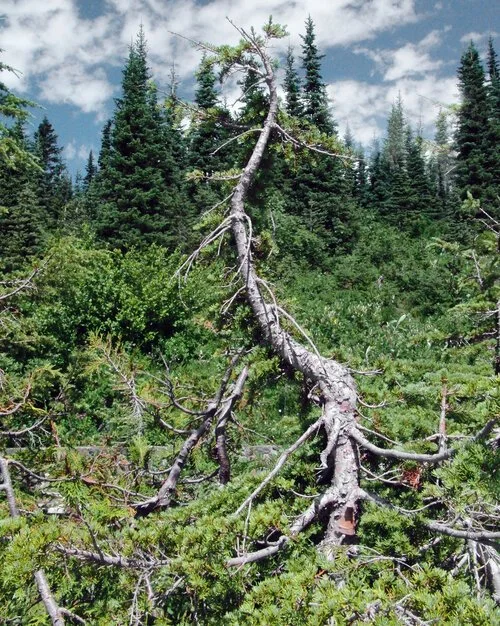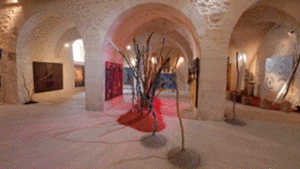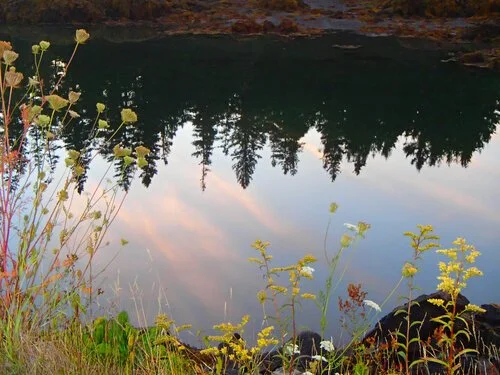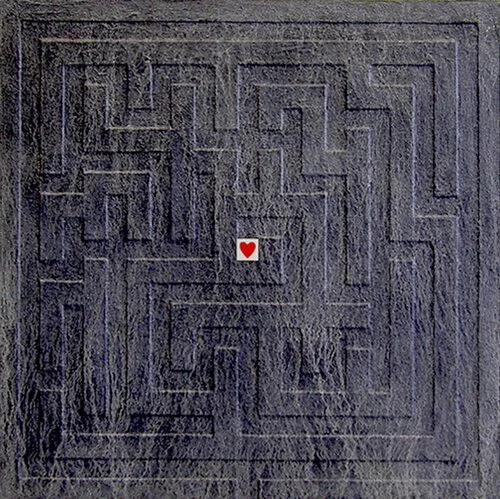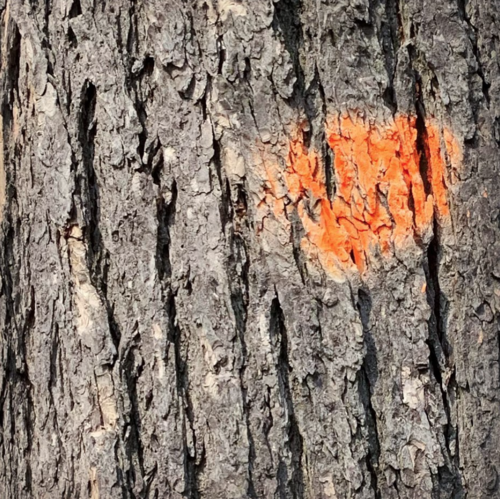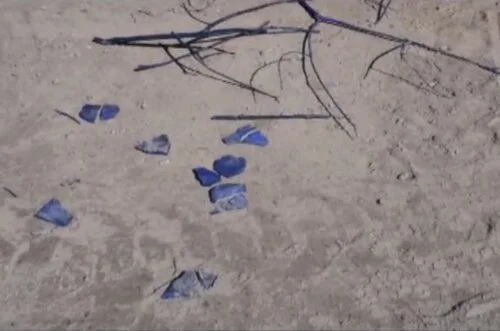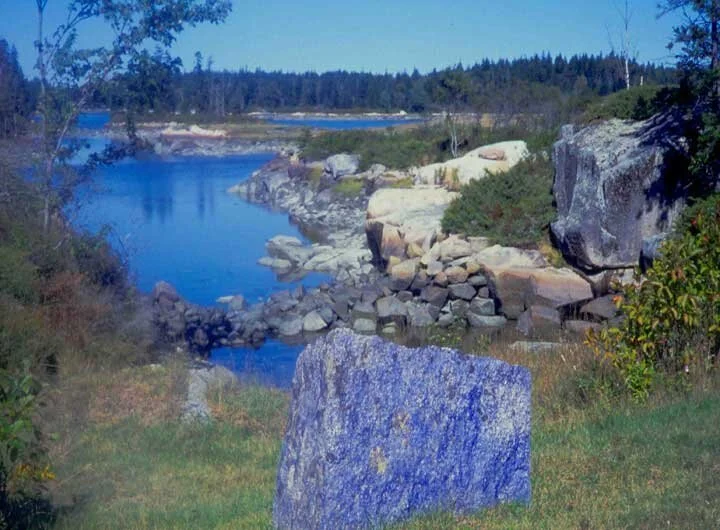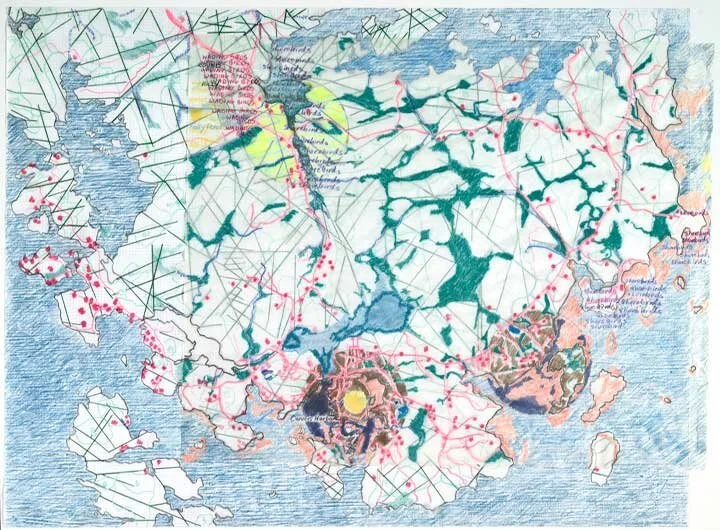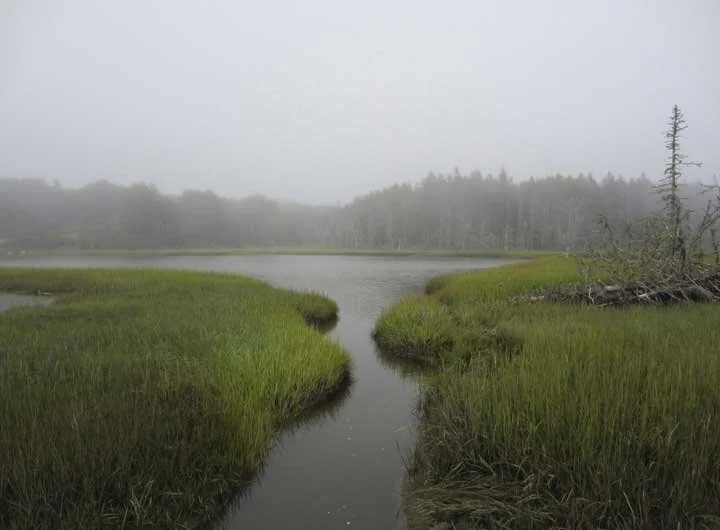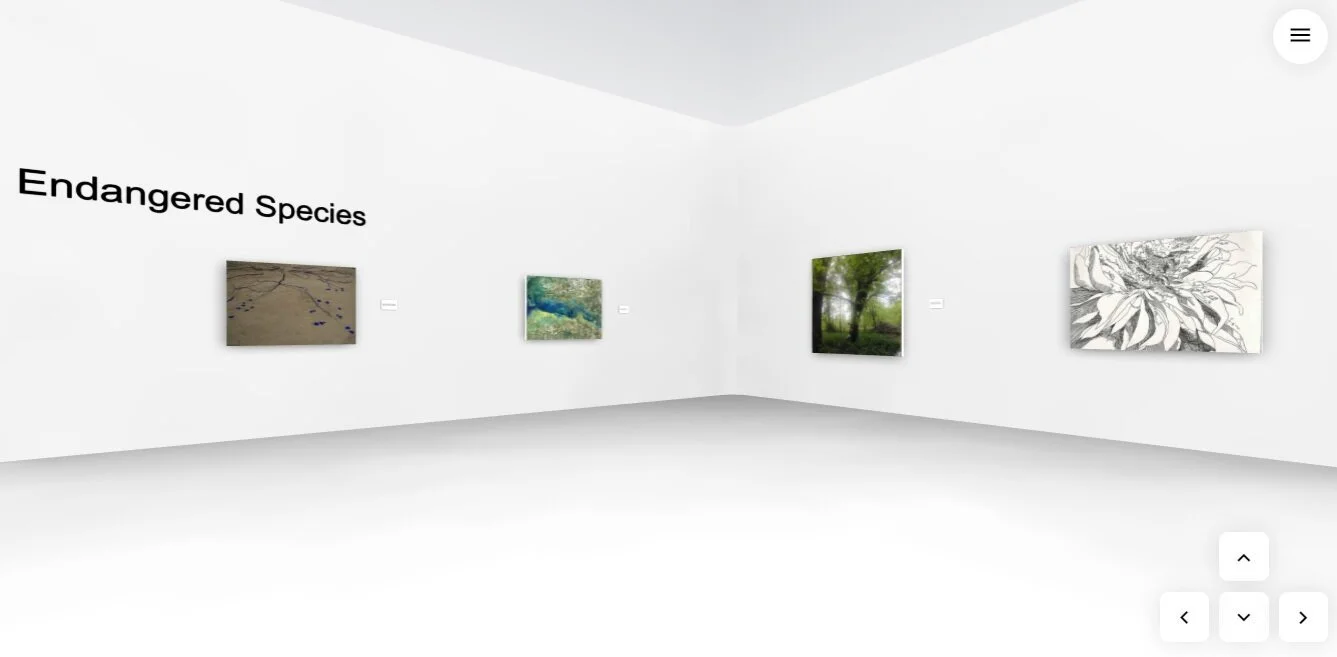Ghost Nets
Ghost Nets (1990-1991) was a multipart habitat restoration project where Trigger Point Theory was developed. Situated on the former coastal town dump of Vinalhaven island in the Gulf of Maine, the project restored 2.5 acres of habitat through conceptual and practical actions that explored soil, land, animal and water relationships: Trigger Point Garden, KindWind, and Traffic Dance.
Aviva Rahmani purchased the site of a former coastal town dump on a fishing island in the Gulf of Maine for Ghost Nets. There, she developed Trigger Point Theory: the idea that small points of carefully selected intervention might effect large systemic transformations.
Ghost Nets restored 2.5 acres of habitat, in the middle of an Atlantic seabird Class A Fly Zone, to a flourishing wetlands system and personal residence. Rahmani designed a passive solar home on the site with Steve Robinson (AIA) and created a complex uplands riparian zone garden and water buffer zones. The project was divided into three parts: 1) the Trigger Point Garden, 2) KindWind, 3) Traffic Dance. Each part was performative, transformative, and explored another aspect of soil to land and water relationships conceptually and practically.
“Ghost Nets, will continue during the decade of global choice, the time period during which urgent ecological choices must be made, according to many environmental groups...Rahmani gave up her sunny 2,500-square-foot loft in New York to move to a remote island off Maine with her dog and cat, a small wood stove and a party line phone. In Ghost Nets…Rahmani will examine how we abuse our natural environment and in so doing, she will seek alternative solutions...Ghost Nets addresses future survival. Human change and commitment can weave together the fragile and the primitive in nature and mankind to shelter the planet...Rahmani will use the processes of building and collaboration during the next nine years of Ghost Nets. This will be accomplished by forming partnerships in Maine with local fishermen and by performing and documenting housekeeping tasks for her own home as part of a wider global effort.” - December 1990 Ghost Nets press release.
'Ghost Nets' Swamp Quarry 1930 Date: 1930 Size: Variable Materials: Black & White photograph Description: Early photograph of what was to became the Ghost Nets site. Photograph courtesy of the Vinalhaven Historical Society.
'Ghost Nets' Bed of Nets Date: 1992 Size: 4' x 4' x 6'7" Materials: Installation of drift nets on a painted iron bed. Description: This installation of recovered drift nets from the former town dump, was part of my meditative practice during the completion of the Ghost Nets project. The bed represents what we collectively “get in bed with” that has resulted in environmental degradation. Photograph by Aviva Rahmani.
'Ghost Nets' Traffic Dance Date: 2013 Size: Variable Materials: Photograph Description: Aerial detail of bioengineering and excavation for 1/3 wetlands acres portion of Ghost Nets which restored a total of 2.5 acres in a Class A Migratory sea bird intercontinental corridor in the Gulf of Maine site. Photograph by Ben Magro.
'Ghost Nets' Storm Surge Line Date: 1997 Size: Variable Materials: Digital photograph Description: Fresh water meeting saltwater across the storm surge line of the Ghost Nets site for the first time in one hundred years at the Ghost Nets site. Photograph by Aviva Rahmani.
'Ghost Nets' Before and After 1.997 and 2007 Date: 1997 and 2007 Size: Variable Materials: Photomontage Description: Aerial shots of the Ghost Nets site showing changes to the uplands riparian zone and estuary over a 10 year time span. Photographs by Ben Magro.
Provenance:
Stills from Ghost Nets have been shown in the following exhibitions: GROUNDED VISIONS: Artistic Research into Environmental Issues, Zurich, Switzerland, November 27, 2015 - March 23, 2016; Works on Water, Marin Community Foundation, Novato, CA, October 5th - Feb 5th, 2012-2013; Beyond Landscape Marin Community Foundation, Novato, CA, June 15th - Sep. 28th, 2012; New Perspectives on Urban Ecology, curated by Alex Tolman Max-Born-Saa, Berlin, Germany, 2010; First International Art and Ecology, invitational workshop and installation, Society for Ecological Restoration, British Park, Jerusalem, Israel, 2000 and Rock Rescue, The Art Center at Kingdom Falls, Belfast, ME, 2000.
Publications:
Tallmer, Jerry. “Artist’s ‘Ghost’ is a 9-year Haunt.” New York Post December 28, 1990.
Schwendenwein, Jude. “Breaking Ground: Art in the Environment.” Sculpture Magazine, September/October, 1991.
Rahmani, Aviva. “Ghost Nets: The Medicine Wheel Garden.” Leonardo 25:1 p. 96, 1992.
Harris, Craig. Leonardo Almanac Massachusetts: MIT Press, 1993.
Rahmani, Aviva. “A Pilgrim’s Progress Experiences in Wetlands Restoration.” Working Waterfront/Inter-Island News November p. 8, 1995.
Lippard, Lucy. The Lure of the Local. New York: The New Press, 1997.
Rahmani, Aviva. “Restoring a ‘pocket’ saltmarsh.” Working Waterfront/Inter-Island News 11 April p. 16, 1998.
Rahmani, Aviva. “Ghost Nets: art meets ecological restoration.” The National Wetlands Newsletter March-April, pp. 3-4, 2000.
Spaid, Sue. Ecovention: current art to transform ecologies. Cincinnati, Ohio: Contemporary Art Center, greenmuseum.org and ecoartspace, 2000.
Sutherland, Amy. “Art-Eco on Vinalhaven.” Maine Telegram. June 10, 2001.
Orenstein, Gloria “The Greening of Gaia: Ecofeminist Artists Revisit the Garden.” Ethics and the Environment. Vol. 8 no. 1, pp:103-111, Spring 2003.
Strelow, Heike. Aesthetics of Ecology: Art in Environmental Design: Theory and Practice. Basel, Berlin, Boston: Birkhauser Verlag fur Architektur, 2004 .
Auses, Jack, Kester, Grant and Strayer, Jenny Eds. Groundworks. Pennsylvania: Carnegie Mellon University, 2005.
Rahmani, Aviva. “Birthing A Virtual Residency.” Available online: http://greenmuseum.org/generic_content.php?ct_id=268, 2005.
Carruthers, Beth. “Mapping the Terrain of Contemporary EcoART Practice and Collaboration.” online posting available at: http://greenmuseum.org/generic_content.php?ct_id=263, 2006.
Rahmani, Aviva. “The Butterfly Effect,” Soundscapes The Journal of Acoustic Ecology, 2007.
Kagan, Sacha and Steinbrugge, Bettina. Eds. Everything Will Be Fine. Germany: Universitat Lueneberg, 2008.
Rahmani, Aviva. “Collaborating with the Earth. Trigger Point Garden” Public , Vol. 41 pp.158-165, 2010.
Boetzkes, Amanda. At the Limit of Form: The Ethics of Contemporary Earth Art. Published by University of Minnesota Press, 2010.
Kagan, Sacha. Art and Sustainability: Connecting Patterns for a Culture of Complexity. Bielefeld, Germany: Transcript Verlag, 2011.
Ingram, Mrill. "Sculpting Solutions: Art-Science Collaborations in Sustainability." Environment Magazine July/August: 24-34, 2012.
Rahmani, Aviva. “A Community of Resistance: Collaborative Work with Science and Scientists.” WEAD Magazine. Online publication Issue 7, CREATING COMMUNITY, available at: http://weadartists.org/communities-art-science, 2014.
Diving Chaos
Aviva Rahmani’s new book - ‘Divining Chaos The Autobiography of an Idea’.
“A spirited memoir of artist, feminist, and environmental activist Aviva Rahmani”.
In this sharply political memoir, Aviva Rahmani tells her story through the unique lens of her trigger point theory, linking the damage that has been done to the environment to her own experiences as a woman. She details the history that led to two seminal projects: Ghost Nets, restoring a coastal town dump to flourishing wetlands, and The Blued Trees Symphony, which applied a novel legal theory to challenge natural gas pipelines about land use.
Divining Chaos reveals the intimate experiences that shaped Rahmani’s life work. Her discussion of trigger point theory argues that we can predict, confront, and determine outcomes to today’s ecological challenges.
See reviews of Divining Chaos here: Reviews
Aviva Rahmani is an artist and researcher, uniquely qualified to explore the intersection of art and the environment. She is an affiliate with the Institute for Arctic and Alpine Research at the University of Colorado, Boulder. Her PhD is from Plymouth University, UK, and her MFA is from CalArts. Rahmani is a coeditor and contributor to Ecoart in Action: Activities, Case Studies, and Provocations for Classrooms and Communities (New Village, 2022) and has contributed to Practical Ecofeminism, Blaze: Discourse on Art, Women and Feminism, and Art, Theory and Practice in the Anthropocene.
Advance Praise
“Aviva Rahmani once collaborated on a performance about rape that included nailing raw kidneys to walls (‘Ablutions’ 1972). In Divining Chaos she nails her own heart to the Earth’s gallery wall and invites us to examine it, a daunting experience of critical life-moments revealing the complex dialectic of violation. Her ‘trigger point theory’ for healing emerges with ecologically inspired art and empathy for the human community and the self. To read about the deflowering of the Earth as personal biography is powerful. Yet, to fight ecocide and regain the symphony of life, we must 'read' and 'listen' to her beautiful, beating heart, an avatar of harmonia mundi.”
— Glenn Albrecht, environmental philosopher; author of Earth Emotions and Solastalgia
“Fluidly oscillating between art, science, poetry, theory, and diaristic prose, Aviva Rahmani offers a memoir of anti-capitalist, anti-ecocidal storytelling imbued with a deep and abiding faith that people and art can interrupt and reinvent the status quo. In twinning deep scientific and theoretical knowledge with her art, she manages a near-impossible task of rendering the world as it is—precarious, violent, dangerous, beautiful. Divining Chaos pairs Rahmani's generosity and vulnerability with her keen eye and prose focused on the urgencies of our times: the need to recuperate the planet and our human and non-human compatriots from an oblivion brought on by greed. Through her art, she gifts hope.”
— Laura Raicovich, writer and curator; author of Culture Strike: Art and Museums in an Age of Protest and former director of the Queens Museum of Art
“Aviva Rahmani’s remarkable Divining Chaos is part bildungsroman, part eco-action guidebook, part pandemic diary, and part portrait of a turbulent time in American art and history. With searing honesty, Rahmani presents her complex multidisciplinary thinking as it has evolved through the twists and turns of a tumultuous life. This is the story of a life in art that is also a life in politics, science, and environmentalism. And, in our dark times, it is also a story of what we may still be able to do to save our planet.”
— Eleanor Heartney, art critic and curator; author of Art & Today and Doomsday Dreams
“Divining Chaos is a compelling and courageous memoir of historical importance, written by a central figure in the emergence of ecofeminist art. Aviva Rahmani makes clear that the same entrenched systems of power enable the abuse of women and the abuse of nature. Her personal experiences of trauma might well have defeated her. Instead, they seemingly empowered her to become a strong and persistent advocate for ecological issues through her artwork, and to challenge the status quo in innovative and effective ways. The book narrates her prescient interdisciplinary approach to environmental problems and her willingness to avail herself of any field of knowledge that can be wielded as a tool in the fight.”
— Julie Reiss, PhD, editor of Art, Theory and Practice in the Anthropocene
Book Links
Highbrow Magazine except “Exploring the Significance of Ecological Art” November 11, 2022:
https://www.highbrowmagazine.com/20090-exploring-significance-ecological-art
Savage Minds podcast, S2 E2, October 3, 2022:
https://savageminds.substack.com/p/aviva-rahmani#details
Ecotopia on KZFR, Episode 667 August 30, 2022:
https://www.ecotopiakzfr.com/2022-archives.html (scroll down for ECO 667, Divining Chaos with Aviva Rahmani)
Emit-Truth Interview by Howard Lovy August 27, 2022:
https://howardlovy.substack.com/p/jewish-author-aviva-rahmani-usesDivining Chaos book review by Peter Clothier, July 15, 2022:
https://revharryc.blogspot.com/2022/07/book-review-divining-chaos-by-aviva.html“Why Telling Effective Stories About the Environment Requires More Than Just Words”
Aviva Rahmani in Conversation with Andrew Keen, for Keen On podcast July 11, 2022:
https://lithub.com/why-telling-effective-stories-about-the-environment-requires-more-than-just-words/
Hunt for the Lost
Hunt for the Lost (2020) was a public art project provoking discourse around “the lost.” Materializing as an open-ended scavenger hunt, participants were asked to look for metaphorical and physical things that bear personal significance. Items include: “lost courage,” “lost heart,” and “lost forest.” “Lost____” signs were designed and displayed on Governors Island NYC, playing off political campaign signage. Submitted “found” items from participants were collected and curated on the website, creating an alternative world of the “found.”
Hunt for the Lost involved considering what we have recently lost and what it might take to find what has been lost. It created an alternative discussion before and after the 2020 presidential election as counterpoint to the politically inflammatory exchanges current in the fall before the vote. This project isn’t just for artists. It’s for anyone struggling with current realities. Can you imagine an alternate reality?
Lost Forests Found:
This collaboration with Mario Requelme (videographer) involved capturing drone footage on Governor’s Island. Views capture Rahmani’s artwork and signage from a range of angles and distances as the drone explores the island. The accompanying score is Rahmani’s own voice.
Signage and Branches on Governor’s Island, NYC
The full complement of signage was installed until Nov. 1 2021 and The blued branch assemblage for Lost Forest was also up until Nov. 1.






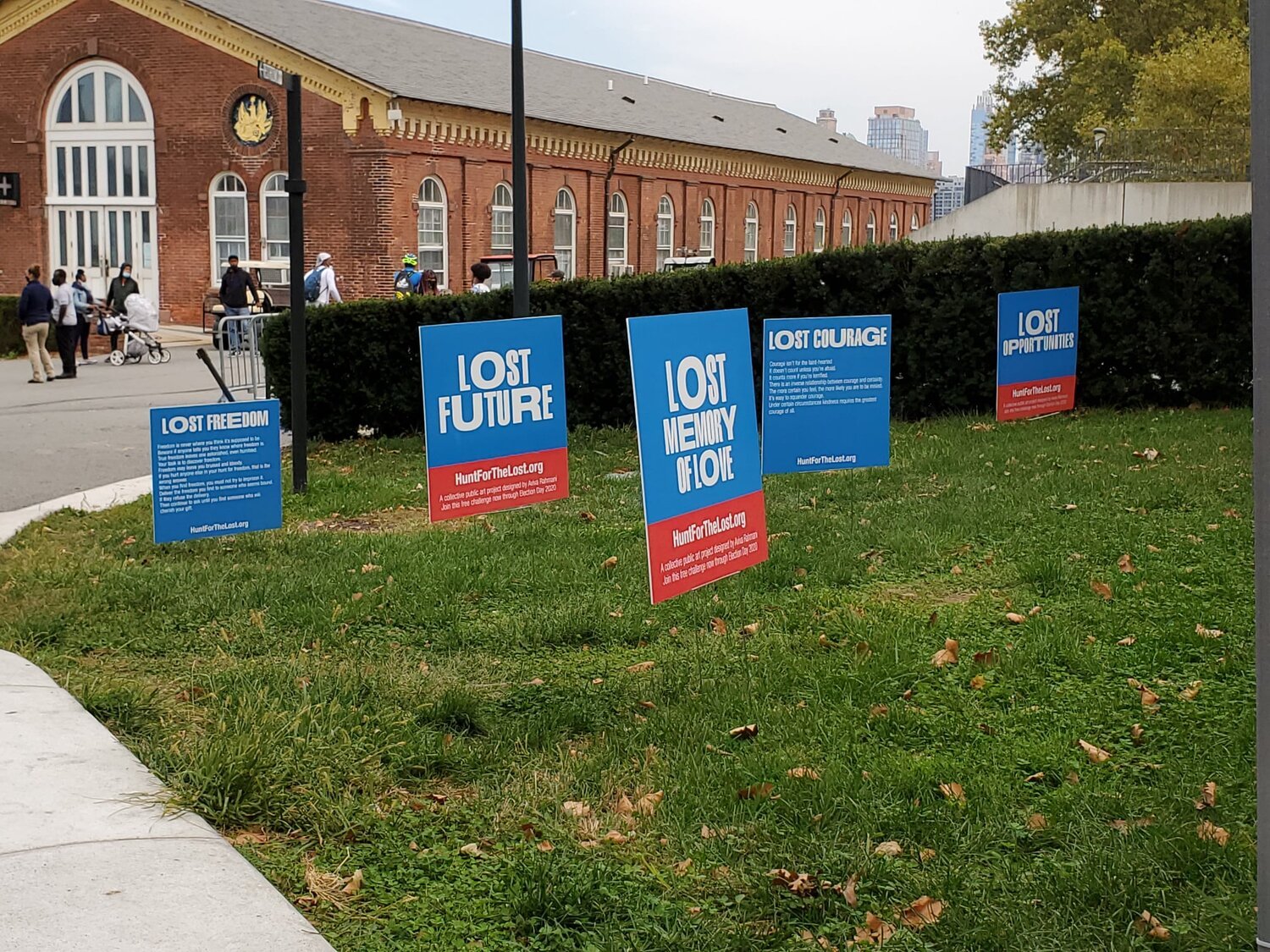
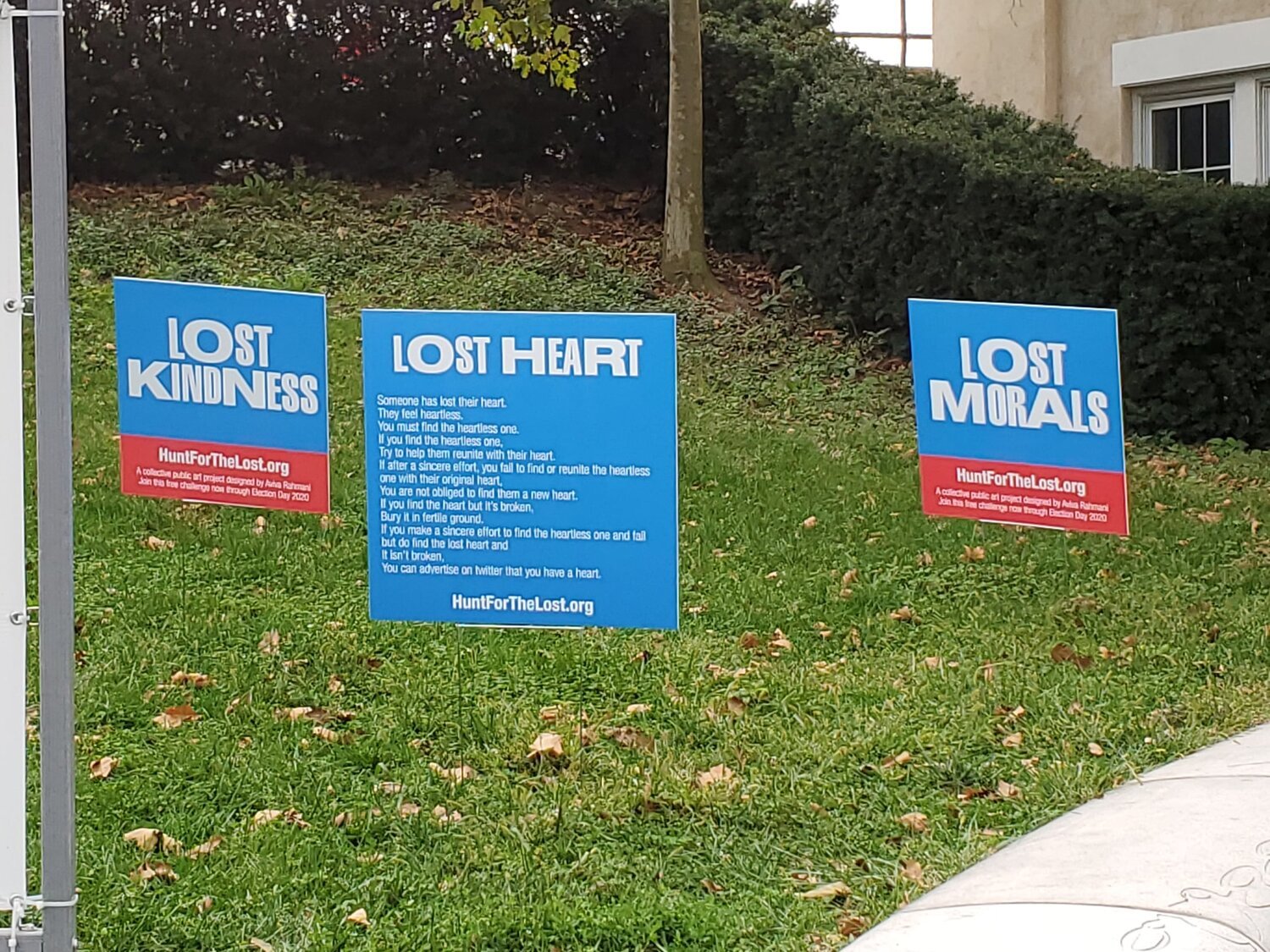



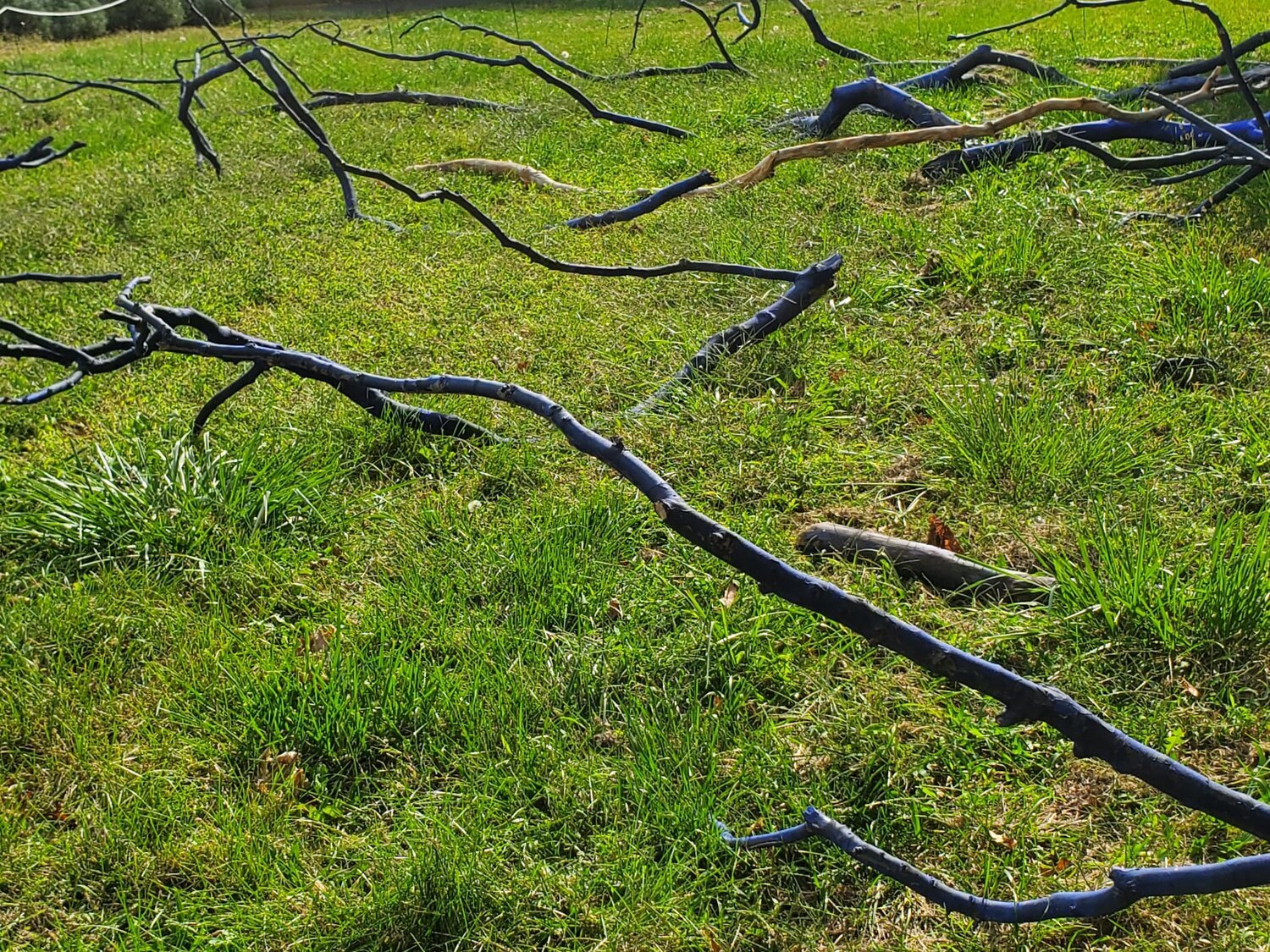
Participating by Social Media or Email
Lost Birds
The public were invited to take part by responding to a number of different prompts and take (or make) a picture, record a sound, journal, or recount the story of their hunt and use the #huntforthelost tag on Facebook or Instagram.
Some of the most popular responses are shown below, for the prompts of Lost Birds, Lost Forest and Lost Hearts, but for a full list of all responses please download this PDF.
Michael Markham Fire Bird Branding Iron, 18.5 inches in length Image, 4 inches (wing tips)
Aviva Rahmani A Beautiful View #7, 2010 Aquatint Print
Nora Nostrand Lost Birds, 2016 Harlem, NYC
Lost Forest
Lost Heart
Ayaka Fujii Receipt from Momo Sushi Shack, 2020 Bushwick, New York
Michael Markham Maze, 1996 acrylic on plywood 4x4 ft.
Judith Mayer
Participating by Post
The last phase of the Hunt for the Lost project involved inviting participants to send their images or messages using the below template.
Blog
For further reading please download Rahmani’s blog for this project by downloading this PDF with the original blog articles dating from September 2020 to January 2021.
Blue Sea Lavender
Blue Sea Lavender (2009) was a series of events and performances in Maine based upon a mythical plant. The one-day event explored the loss of species diversity in the Gulf of Maine mediated through the narration of Blue Sea Lavender who has “lost my children, my family, my community, my home.” The event included consecutively singing Puccini's Vissi d'arte in a public preserve over a six-hour period. The day before, large drawings of the mythical plant were created on the sand of two local preserve parking lots using branches, rocks and water, knowing that cars would destroy the drawings, as people have destroyed many species across the earth.
The event was a sequence of performances during the one-day “site-specific" show curated by Pat Nick on August 19, 2009. A subtheme of the show was the celebration of recently installed wind power turbines on Vinalhaven Island to serve the Fox Islands.
Blue Sea Lavender Date: 2009 Size: 20” x 20” Materials: Drypoint printDescription: Created for the Site Specific exhibition curated by Pat Nick, Vinalhaven Island Maine.
Blue Sea Lavender detail on Echoes of the Islands Date: 2009 Size: 8’ x 5’ x 3’ Materials: Granite rock and casein paint slurry of ultramarine pigment and buttermilk powder, on two sculptures previously created by Aviva Rahmani. Description: One of five temporary installations on the topic of species loss for the Site Specific exhibition. Located at the Vinalhaven Ferry Terminal, Vinalhaven Maine. Photograph by Aviva Rahmani.
Blue Sea Lavender detail at Lane's Island Date: 2009 Size: 70' x 45' Materials: Branches, rocks and casein paint slurry of ultramarine pigment and buttermilk powder. Description: One of five fragile temporary installations on the topic of species loss for the Site Specific exhibition. Located at Lane’s Island Preserve Parking Lot, Vinalhaven Maine. Photograph by Aviva Rahmani.
Blue Sea Lavender detail at VHLT Date: 2009 Size: 85' x 40' Materials: Casein paint slurry of ultramarine pigment and buttermilk powder in sand. Description: One of five fragile temporary installations on the topic of species loss for the Site Specific exhibition. Located at Vinalhaven Land Trust parking lot, Vinalhaven Maine. Photograph by Aviva Rahmani.
Provenance:
Stills from Blue Sea Lavender were shown in the following exhibition: Blue Sea Lavender for Site Specific curated by Pat Nick, New Era Gallery, Fog Gallery and other locations on Vinalhaven Island, ME, 2009.
Publications:
Duncan, Jamie. “Contemporary Art That Beautifully Raises Awareness” ecosalon.com http://ecosalon.com/contemporary-art-that-beautifully-raises-awareness/ posted January 23, 2016.
Blue Rocks
Blue Rocks (2002) was an example of what curators Amy Lipton and Sue Spaid termed an ecovention, a place where art intervenes in environmental degradation. Forty large boulders painted blue, drawing attention to an obstructed causeway on Pleasant River, Vinalhaven Island, Maine. The ecovention included the painting of the boulders by the river and a “wash-in,” which came as a response to being subpoenaed from the town to clean the rocks, to educate the local community about estuarine health. The project included GIS mapping. The site choice applied Trigger Point Theory. My task was to investigate how the restoration of this small site could have regional impact. It was at a significant confluence of ecotones (transitions between systems).
In 2002, Blue Rocks was initiated at Pleasant River on Vinalhaven Island, Maine. Aviva Rahmani painted forty large boulders around an obstructed causeway, with a casein slurry of nontoxic ultramarine pigment, buttermilk, and native mosses to encourage the growth of more moss. When the town of Vinalhaven subpoenaed the artist to wash the rocks clean, she announced a “wash-in,” and used the occasion to educate passers-by about estuarine health. The attention to the site contributed momentum to a commitment from the USDA of over $500,000 to restore a total of twenty-six critical wetland acres.
There were two goals:
1. To test her Trigger Point Theory by seeing if the restoration of a small site could have a regional impact. In aerial photography, the two sides of the island look like the chambers of a beating heart. The Army Corps of Engineers had narrowed the causeway, which impeded tidal flow between fresh and saltwater, causing stagnation.
2. To explore how to catalyse a chain reaction of events (by drawing attention to the site with the painted rocks and a subsequent wash-in) that would catalyse a thriving community relationship to a healthy ecosystem.
The site was selected by analysing relevant Geographic Information Systems (GIS) mapping. That GIS work was completed by Gordon Longsworth of the College of the Atlantic for the Vinalhaven Land Trust. Rahmani’s GIS analysis was based on her work as chair of the Natural Resources Subcommittee for the 2005 Vinalhaven Comprehensive Plan.
Detail of Blue Rocks Date: 2002 Size: Variable Materials: Photographic detail of 40 painted boulders in a causeway Description: Granite boulders painted with a casein slurry of buttermilk and non-toxic ultramarine blue pigment.
Blue Rocks Materials Date: 2002 Size: Variable Materials: Granite boulders painted with a casein slurry of buttermilk and non-toxic ultramarine blue pigment. Description: Materials for painting granite boulders.
GIS for Blue Rocks Date: 2002 Size: 17" x 23" Materials:Photoshop on colored pencil drawing layers, based on GIS mapping Description: Imaging where biogeographic data overlaps for a critical location of the Gulf of Maine.
Blue Rocks Pleasant River August 2012 Date: 2012 Size: Variable Materials: Photograph Description: Pleasant River, site of Blued Rocks project 10 years after restoration work. Photo by Aviva Rahmani.
Provenance:
Stills from Blue Rocks have been shown in the following exhibition: In the Green curated by Audra Bowsky, Woman Made Gallery website, March 20 - April 22, 2013.
Publications:
Rahmani, Aviva. "Why Blue Rocks?" Available online at: http://greenmuseum.org/content/artist_content/ct_id-91__artist_id-23.html, 2002.
Denson, Roger. "Nomads Occupy the Global Village: Left Political Art Timeline, 2001-2012" The Huffington Post. May 1, 2012.
Summary: Lost & Threatened Plants and Animals
Species biodiversity is important to preserve resilience for the health of the planet, its ecologies, and human life. Pressure from human activities is causing an ever-accelerating threat to many different species of plants and animals. The giant panda or the polar Bear may be the most emblematic of critically endangered animals in the popular imagination, but many other charismatic animals are endangered by anthropogenic activities such as the blue macaw, Sumatran tiger, green sea turtle, spotted owl, and California condor. Still, they are only the top of an iceberg that includes countless insects critical to pollination as well as many other mammals and plants that attract less attention and reverence. At the time of this writing, the International Union for Conservation of Nature (IUCN) has assessed 120,372 species of animals and plants and have awarded the status of “threatened” to 32,441 — over 25 percent. The figures of species under threat of extinction are staggering. For example, 25 percent of mammals, 41 percent of amphibians, and 13 percent of birds.
Through many of her ecoart projects, Aviva Rahmani has flagged the crises that life on Earth faces, particularly over the ecosystems that protect both fresh and saltwater, such as estuaries She confronts the vital importance and interconnectedness of complex roles that different species play in healthy ecosystems. Many of her projects explore how art can catalyse change in the environment and positively impact or even reverse our movement toward plant and animal extinction.

